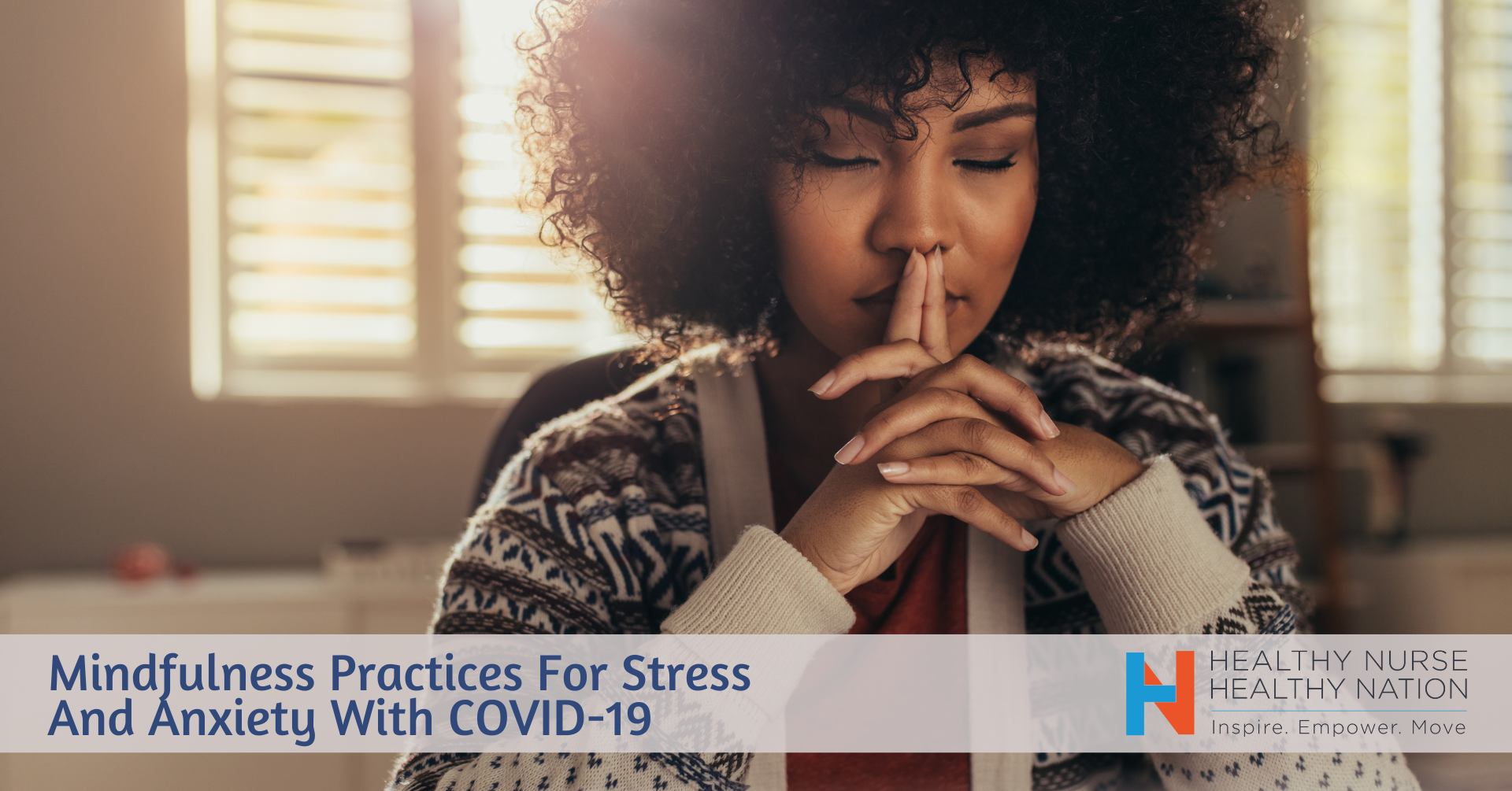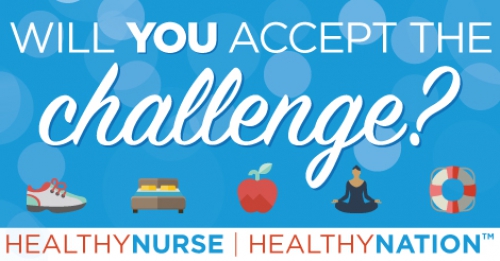Mindfulness Practices For Stress And Anxiety With COVID-19
Published
By Julia Sarazine, DNP, APRN, FNP-BC, a nurse practitioner and certified mindfulness teacher who is passionate about teaching mindfulness to health care professionals and the community.

Have you experienced increased irritability, felt overwhelmed and exhausted or had difficulty falling asleep?
These are all symptoms of burnout are more common currently among health care professionals due to the increased stress and anxiety from the COVID-19 pandemic as documented in an Italian study (Barello, 2020).
So, if you are experiencing any of these symptoms, you are not alone. It is an unprecedented time for the entire world and especially for health care providers whom are taking care of patients. It is more important now than ever for nurses to take care of themselves first while they take care of others.
Experiencing burnout and practicing mindfulness is very personal to me. While working as a palliative care nurse practitioner in an inner city hospital and caring for patients while dying, I became burned out. The symptoms of burnout began gradually but eventually slipped into all aspects of my life, both personally and professionally. I felt emotionally and physically exhausted, withdrew socially, experienced insomnia and stopped connecting with patients emotionally. In the early 2000’s no one spoke of “burnout” and how to cope with it. I left the nursing profession but returned to the same position five years later with a mindfulness practice. I still use this skill everyday as I teach mindfulness to healthcare professionals, veterans with PTSD, and community members.
What is mindlessness?
The mind naturally wanders from the present moment to the past or future. This is often referred to as autopilota nurse practitioner and certified mindfulness teacher who is passionate about teaching mindfulness to health care professionals and the community.
- Have you ever commuted to work and not remembered the drive or train ride?
- Have you ever eaten something and not remembered tasting it?
- Have you ever reacted to a situation and later regretted how you handled it?
Mindfulness is paying attention in the present moment, with kindness.
Why practice mindfulness?
Research shows mindfulness is effective in decreasing stress, anxiety and depression. Specifically, a study showed nurses had a statistically significant decline in stress and burnout and an increase in mindfulness skills six months after a four-hour mindfulness workshop (Sarazine et al, 2020) (Guillamie et al, 2017).
- Mindfulness has also been found to have a physiologic effect by shifting people from the sympathetic (fight of flight) to parasympathetic (rest and digest) nervous system. This is extremely valuable as it decreases the stress hormone cascade of cortisol, epinephrine and norepinephrine and increases the release of oxytocin (Pascoe et al, 2017).
Meditation
To increase the ability to be present in our lives, it is helpful to meditate each day with a guided mediation that focus on breathing, walking or yoga to build our muscle of attention and awareness.
Mindfulness Techniques
Here are some strategies and tips to incorporate into your daily life especially at work, where stress levels can be elevated. It does not take any more time to be mindful.
STOP
STOP is a mindful technique to reconnect with our bodies. It can be used before entering a patient’s room, sending a text, speaking, or entering your home after work. The acronym STOP stands for:
- Stop whatever you are doing to pause for a moment.
- Take a deep breath or two.
- Observe any specific thoughts, emotions, or body sensations.
- Proceed with more awareness.
This mindful technique can be used in times of stress to ground us and create a little space from the stressful situation being encountered.
With both feet firmly on the ground, while either standing or sitting:
- Focus as much attention as possible on sensations in the sole of the left foot—perhaps pressure or sensations from contact with the sock or shoe.
- Then shift attention to sensations in the sole of the right foot, with as much attention as possible.
- Tune in to your breathing—just feeling the breath as it moves in and out.
- Now, continue whatever you are doing in a more grounded and present way.
Mindful Hand Washing
Use all the senses to bring awareness to the activity of washing the hands. Feel the temperature of the water and the sensations of the hands rubbing together, the smell of the soap, and the sound of the water running, and notice the bubbles forming from the soap. This awareness can be applied to any routine activity, such as brushing teeth, taking a shower, or charting.
Mindful Eating
First, take time to appreciate everything involved in growing and preparing the food that is available to eat. Someone planted the seed; it received sunlight and water; someone picked the fruit or vegetable, loaded it onto a truck, cleaned and packaged it in a factory, transported it to the neighborhood grocery store, placed it on the shelf; and it was purchased with the assistance of a cashier at the store.
Second, when eating a meal or snack, use the senses to be as present as possible, even if it is just for a few bites. Look at the colors and shapes of the food, notice the smell, feel the texture of the food between your fingers or in your mouth, notice the taste of the food and, if possible, the sound of the food as you eat it. The focus is on just feeling gratitude and being as present as possible.
Lastly and most importantly, thank you for all of the compassionate work you are doing everyday.
Free Mindfulness Apps with instructions and guided meditations:
- Insight Timer - https://insighttimer.com/
- Smiling Mind (for children) - https://www.smilingmind.com.au/smiling-mind-app
References
1. Barello S, Palamenghi L, Graffigna G. Burnout and somatic symptoms among frontline healthcare professionals at the peak of the Italian COVID-19 pandemic. Psychiatry Research (2020) doi.org/10.1016/j.psychres.2020.113129
2. Sarazine J, Heitschmidt M, Vondracek H, Sarris S, Markincowski N, Kleinpell R. Mindfulness workshops effects on nurses’ burnout, stress and mindfulness skills. Holistic Nursing Practice (2020) doi: 10.1097/HNP.0000000000000378
3. Guillaumie L, Boiral O, Champagne J. A mixed-methods systematic review of the effects of mindfulness on nurses. Journal of Advanced Nursing. 2017 May; 73 (5):1017-1034.
4. Pascoe M, Thompson D, Jenkins Z, Ski C. Mindfulness mediates the physiological markers of stress: Systematic review and meta-analysis. Journal of Psychiatric Research. 2017; 95: 156-178.
Updated 5/7/25

Have you joined Healthy Nurse, Healthy Nation (HNHN) yet? Join us today!
Blog Mental Health
08/05/2020 12:42pm CDT



Post a Comment or Question